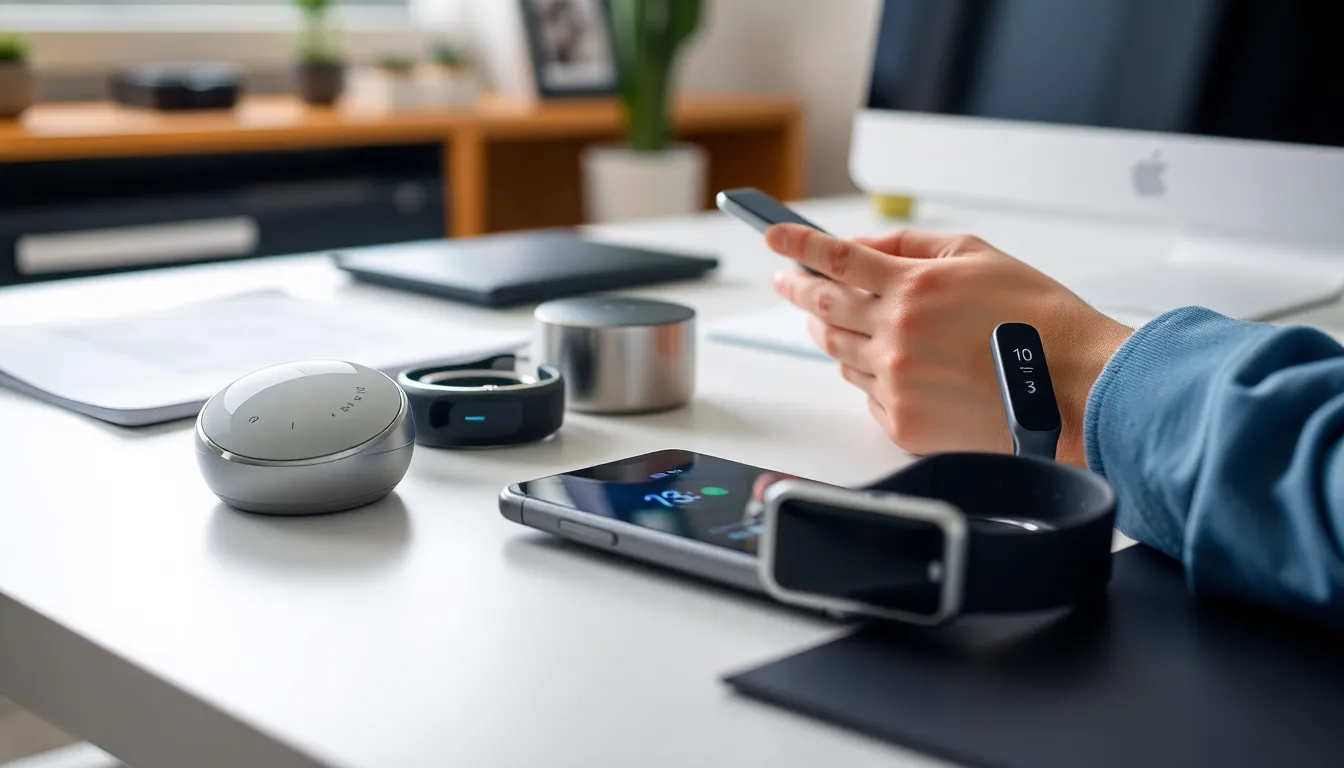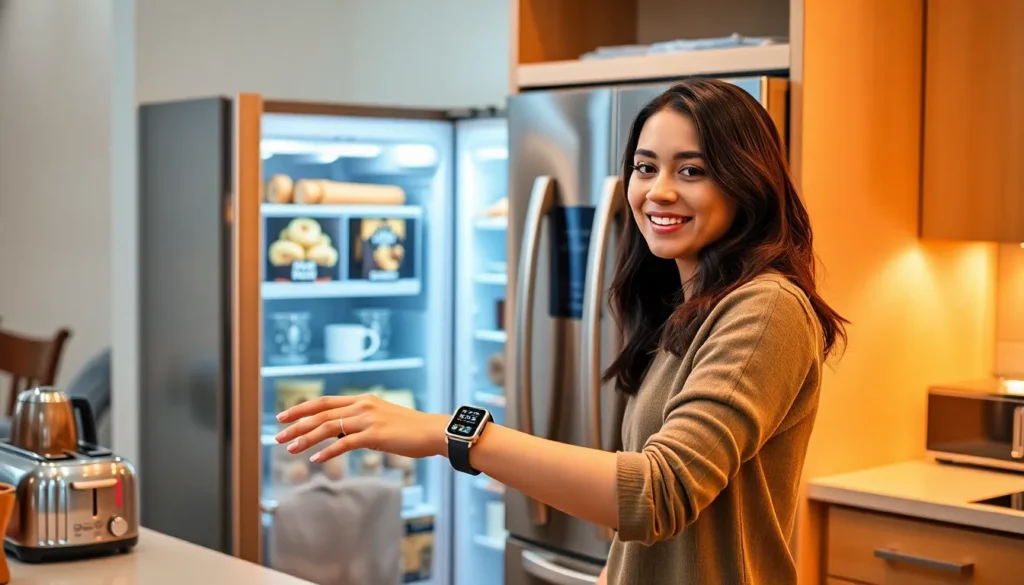Table of Contents
ToggleImagine a world where your toaster and refrigerator gossip about your breakfast choices while your thermostat argues with your coffee maker over the perfect brewing temperature. Welcome to the Internet of Things (IoT), where everyday objects connect to the internet and to each other, creating a smart ecosystem that’s as convenient as it is quirky.
In this digital playground, everything from your smartwatch to your home security system is in on the action. With the IoT, mundane tasks become effortless, and your home transforms into a responsive haven. But don’t worry, it’s not just about making life easier; it’s about making it smarter too. Dive into the fascinating realm of IoT, where innovation meets everyday life, and discover how these connected devices are revolutionizing the way we live, work, and play.
Overview of Internet of Things
The Internet of Things (IoT) refers to a network that connects various devices and appliances to the internet. This network enables communication and data exchange among a wide range of objects, including smartwatches, home security systems, and even kitchen appliances. Each device collects and shares data, enhancing its functionality and allowing users to monitor and control them remotely.
Connected devices strive to enhance convenience in everyday tasks. For example, smart thermostats learn user preferences and adjust temperatures automatically, providing comfort while optimizing energy use. Smart refrigerators can track inventory, suggest recipes, and notify when items are running low.
Data generated from these devices offers insights that were previously unavailable. Manufacturers can analyze usage patterns to improve products, while consumers benefit from personalized experiences tailored to their habits and preferences. Businesses gain operational efficiencies through connected systems that streamline processes and reduce overhead.
Security in IoT ecosystems remains a crucial consideration. Vulnerable devices can provide entry points for cyberattacks, potentially compromising personal and sensitive information. As a result, manufacturers are investing in stronger security protocols to protect users.
The Internet of Things is revolutionizing how people interact with technology. This interconnected system is not merely about convenience; it encompasses enhanced efficiency, data-driven decision-making, and increased security. IoT’s impact resounds across various sectors, positioning itself as a cornerstone of modern technological advancement.
Key Components of Internet of Things

Key components drive the functionality of the Internet of Things. Understanding these elements enhances comprehension of how IoT operates seamlessly in everyday life.
Devices and Sensors
Devices and sensors form the backbone of IoT architecture. Smart home appliances, wearables, and industrial sensors collect real-time data. Temperature sensors in smart thermostats adjust room conditions based on user preferences. Wearable fitness trackers monitor physical activities and send data to apps for analysis. By leveraging these devices, users gain insights into behaviors and trends, enabling smarter decisions.
Connectivity Protocols
Connectivity protocols ensure seamless communication among devices. Wi-Fi, Bluetooth, and Zigbee represent common protocols that facilitate data exchange. Wi-Fi allows devices with higher bandwidth requirements to connect efficiently, while Bluetooth offers energy-efficient connections for short-range communication. Zigbee supports many devices in smart homes, creating a reliable mesh network. Different protocols cater to various needs, making it vital to select the appropriate one for specific applications.
Data Processing and Analysis
Data processing and analysis transform raw data into actionable insights. Cloud computing platforms perform extensive data storage and processing, handling vast amounts generated by devices. Real-time analytics helps users make immediate decisions based on data trends. Machine learning algorithms identify patterns and predict future behaviors, enhancing device performance. This process turns IoT data into valuable information for users and manufacturers alike, driving innovation and efficiency.
Applications of Internet of Things
The Internet of Things (IoT) finds extensive application across various sectors, enhancing efficiency and convenience.
Smart Homes
Smart homes utilize IoT technology to increase comfort and security. Devices such as smart thermostats allow homeowners to control heating and cooling remotely. Smart lighting systems enable automated adjustments based on occupancy or time of day. Home security systems equipped with IoT features provide real-time monitoring and alerts through smartphones. These interconnected devices contribute to energy savings while creating a more personalized living environment.
Industrial IoT
Industrial IoT transforms manufacturing and logistics by improving operational efficiency. Sensors installed on machinery collect data in real time, enabling predictive maintenance and reducing downtime. Supply chain management benefits from IoT through enhanced tracking of shipments and inventory levels. Smart equipment analyzes performance data, facilitating optimization of production processes. The integration of IoT in industry results in decreased costs and increased productivity.
Healthcare Innovations
Healthcare leverages IoT to enhance patient care and streamline processes. Wearable devices monitor vital signs and transmit data to healthcare providers in real time. Telemedicine solutions utilize IoT for remote consultations, improving access to care. Smart medication dispensers remind patients to take medications on time. As a result, healthcare professionals can make informed decisions based on up-to-date information while promoting better patient outcomes.
Challenges and Concerns
The Internet of Things (IoT) presents various challenges that impact its effective implementation and adoption. Understanding these issues is crucial for stakeholders across sectors.
Security Issues
Security vulnerabilities pose significant threats to IoT ecosystems. Devices often serve as entry points for cyberattacks, allowing unauthorized access to sensitive information. In fact, 70% of IoT devices experience security challenges, according to industry reports. Manufacturers increasingly focus on enhancing security protocols to mitigate these risks. For instance, using encryption and regular firmware updates can strengthen device security. Additionally, implementing strong authentication measures is vital for protecting user data. As IoT expands, ongoing vigilance becomes essential to address these evolving security threats.
Privacy Concerns
Privacy concerns arise with the widespread data collection by IoT devices. Devices frequently gather personal information, often without users’ explicit consent. Statistics indicate that 79% of consumers worry about how their data is used. Manufacturers face pressure to establish transparent data policies that detail data usage and sharing practices. Users, in turn, might opt for devices that prioritize privacy and minimize data collection. Responsible data management practices help foster trust between consumers and manufacturers, supporting the growth of IoT while addressing privacy challenges.
Future Trends in Internet of Things
Emerging technologies continually shape the future of the Internet of Things (IoT). Artificial intelligence integration enhances the capabilities of connected devices. Data processing evolves, making devices smarter and enabling them to learn user preferences in real time. Machine learning algorithms analyze behavioral patterns, improving performance through ongoing interactions.
Data security remains a priority as the number of connected devices increases. Manufacturers focus on developing advanced encryption techniques to protect user information. Moreover, compliance with privacy regulations becomes critical in ensuring consumer trust. A recent report indicates that 70% of IoT devices face security challenges, highlighting the urgency for improved security measures.
Healthcare applications are on the rise, presenting innovative solutions for patient monitoring and telemedicine. Wearable devices track vital signs and communicate data directly to healthcare providers. Remote patient management systems optimize care delivery through real-time data sharing. Efficiency and access improvements significantly enhance patient outcomes.
Smart cities will emerge as a significant trend, integrating IoT technology into urban infrastructure. Sensors monitor traffic patterns, reducing congestion and improving public transportation systems. Energy management systems regulate consumption, contributing to sustainability efforts. Citizens benefit from improved services and a higher quality of life.
Lastly, the adoption of edge computing marks a shift in data processing capabilities. By processing data closer to the source, devices reduce latency and enhance real-time decision-making. This development supports the growing demand for instantaneous responses across various applications. As these trends unfold, the future of the Internet of Things promises to transform interaction with technology profoundly.
The Internet of Things is reshaping how individuals and industries interact with technology. As devices become increasingly interconnected, they enhance convenience and efficiency in daily life. This transformation not only streamlines tasks but also empowers users with valuable insights for smarter decision-making.
While the benefits are significant, addressing security and privacy concerns remains essential. As the IoT landscape evolves, manufacturers are prioritizing robust security measures to protect users. The future promises even more advancements, with artificial intelligence and machine learning driving innovation and improving user experiences.
Embracing the Internet of Things means stepping into a smarter world where technology works seamlessly to improve quality of life. As this ecosystem expands, staying informed about its developments will be crucial for maximizing its potential.







